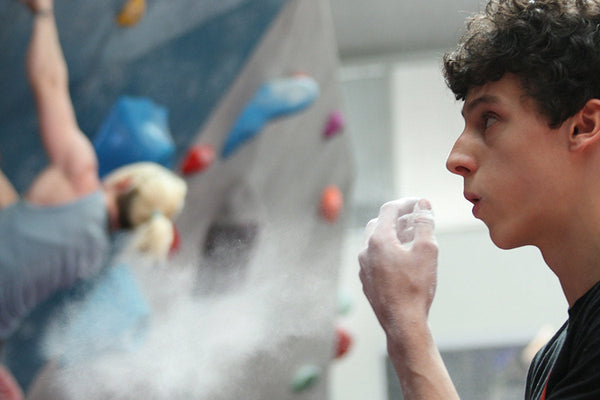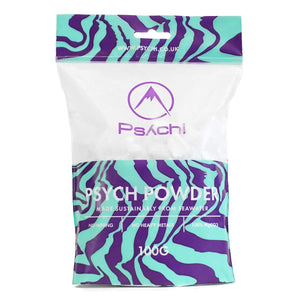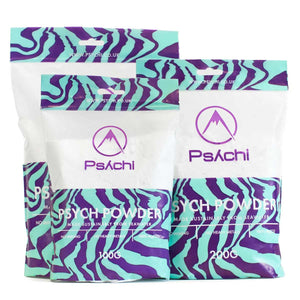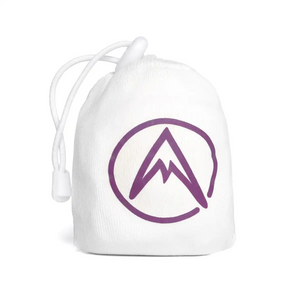Why Do Climbers Use Climbing Chalk?
If you are new to the climbing world or have ever seen videos or images of people climbing, you may be curious as to why climbers are always dipping their hands into bags of climbing chalk. Well, to explain this strange ritual I have created a short guide to put your inquisitive minds at ease! Many of us think that the use of chalk whilst climbing gives us extra grip strength. This is in fact untrue. People new to climbing often confuse the use of chalk with an increase in grip rather than an increase in friction. This then means they think more is better. In this short blog I will try to explain why and how you should use climbing chalk and recommend some of the best chalk options for climbing and bouldering at all levels.
WHY? DO I REALLY NEED TO USE CLIMBING CHALK?
If you go to any indoor climbing centre or outdoor crag and you will see most people with a chalk bucket on the floor or chalk bag around their waist. They will regularly be dipping their hands in before they attempt any climb or boulder problem. This results in plumes of chalk in the air and climbing holds turning white over time. When we climb we often attempt to have 4 points of contact with the wall, two feet and our hands, this exudes energy and therefore results in our bodies producing sweat. With climbing shoes on our feet and sticky rubber to help with grip, sweat does not cause us an issue. The same cannot be said for our hands as the are in direct contact with the rock or climbing holds and unlike our feet, we have no rubber for extra grip. As such, sweaty palms can be a nightmare when climbing, causing you to slip off holds and making it a whole lot more challenging to top out.
HOW DO I USE CLIMBING CHALK? HOW MUCH CLIMBING CHALK SHOULD I APPLY?
It is perspiration that was the reason that chalk was originally introduced into the climbing world to combat sweaty palms. Climbing chalk is needed to dry the sweat produced on our hands whilst climbing, there are many people who climb who do not suffer from sweaty palms. This means that you would not need to use chalk or a limited amount if you do not suffer from sweaty hands. A light covering of chalk on sweaty palms can help get the required friction back to ensure you can climb your project. If you look closely at indoor climbing holds they are often textured. This rough surface paired with dry hands creates the friction needed to help you grip holds.
There are many new climbers who presume that chalk is a necessity for climbing without fully realising its use. Chalk will NOT help your grip strength, only improve the friction between hand and hold. As such, if you do not suffer from sweaty palms then the chalk will do little to improve your climbing. That said, the vast majority of climbers do suffer from sweaty hands and chalk will be your best friend. A light dusting from your chalk bag or bucket, is perfect to dry the sweat and ensure you have dry hands when you grip the holds and to give you the best friction needed to grip the holds and send your project.
READY TO LEVEL-UP YOUR GRIP?
Browse our full range of chalk below!
Chalk
CAN YOU USE TOO MUCH CLIMBING CHALK?
Yes! If you use too much climbing chalk on your hands, you will create a layer of chalk between your skin and the holds, this layer will of chalk will have a negative effect on the friction you are trying to achieve. Remember, we are only trying to dry the sweat, not cover our whole hands in a thick layer of chalk. As such you need to use chalk sparingly and only use enough to dry your hands. You can see the in the images below images the correct amount of chalk to use and an excessive amount.
So now we know a little about chalk use and why we use it, let's look at what else we can do to ensure that hand/hold friction is as good as we can make it.
WHAT'S THE BEST CLIMBING CHALK?
There are many different forms of chalk available to buy, this is often down to personal preference.
We think these are the best climbing chalk options:
Psychi Loose Chalk Ideal for chalking hands from a large bouldering bucket or bag. Crumbled chalk, already broken down, unlike the block format. A boulders first choice. Psychi Block Chalk For those that like to break the chalk down into bigger chunks, the closest form to loose chalk. Can be used in any form of chalk bag, better in a bigger bucket. Psychi Chalk Ball Ideal to fit in a smaller waist chalk bag. Squeeze to get a good chalk coverage. A route climbers go to form of chalk. Psychi Refillable Ball Same as the standard chalk ball with an added drawstring top. This ball can then be refilled using loose or block chalk. Psychi Liquid Chalk Often used in line with the chalks above. Stays applied for longer than conventional powder chalk and often used as a base layer that can then be chalked over with powder if needed. Great for them extra sweaty days at the gym or crag. Weightlifters and crossfit users favorite as it creates less mess than standard powder chalk and you do not need a chalk bag to use it.
CLEANING HOLDS!
As I mentioned earlier in the article, climbing holds are textured. This is the case whether you are climbing indoors or out. Excess chalk has the same effect on climbing holds as it does on our hands. After continued use, climbing holds get covered in chalk and rubber from climbing shoes which diminishes the texture of the climbing holds and therefore loses the friction between hand and hold that is so important to our grip whilst climbing. The tiny holes and bumps that appear on climbing holds are key to the creating the friction we need and therefore need to be kept clean if we are to climb efficiently on them. A simple brush of the dirty hold to clean off any excess chalk and rubber can make so much difference. Next time you see a dirty hold, give it a clean and how much difference it can make to the grip you can get on the hold! Cleaning holds is not only important, but easy to do with plenty of cleaning brushes available in all shapes and sizes. We recommend the Psychi Large Boar Hair Brush for Large holds and slopers.
GET YOUR CLIMBING CHALK & BRUSHES ONLINE
Browse our range of climbing chalk and brushes!
Read our Ultimate Climbing Chalk Guide for more information on climbing chalk!















